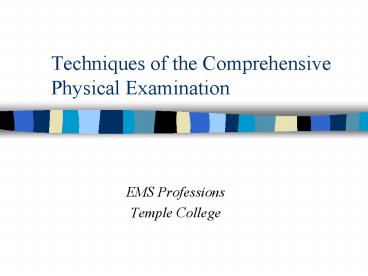Techniques of the Comprehensive Physical Examination - PowerPoint PPT Presentation
1 / 20
Title:
Techniques of the Comprehensive Physical Examination
Description:
Techniques of the Comprehensive Physical Examination. EMS Professions. Temple College ... How would these things affect your physical exam? Group Discussions ... – PowerPoint PPT presentation
Number of Views:924
Avg rating:3.0/5.0
Title: Techniques of the Comprehensive Physical Examination
1
Techniques of the Comprehensive Physical
Examination
- EMS Professions
- Temple College
2
Objectives
- Review the general approach and systematic method
used in performing a comprehensive PE - Pathophys will discuss abnormal findings specific
to disease - Patient Assessment will discuss focusing the PE
as needed - Use small group discussions to define the issues
3
Discussion Groups
- Group 1
- Daniel, Stephanie, Kristine, Elvie
- Group 2
- Jennifer P, Roy, Jennifer D
- Group 3
- Angela, Crystal, Aaron
4
Discussion Group Guidelines
- Work as a Team
- Everyone contributes to the success failure of
the Team - Respect each team members ideas
- Rotate the role of team leader, note-taker, and
spokesperson - Open your minds Think Broadly
- Learn from each other
5
What is the purpose of a Comprehensive Physical
Exam?
- Why is it performed?
- What should you expect to gain from it?
- What should you not expect to gain from it?
- Group Discussions
6
Techniques Used in Physical Exam
- Inspection
- Palpation
- Percussion
- Auscultation
7
Percussion
8
Tools of the Physical Exam
- Stethoscope
- BP cuff
- Otoscope
- Ophthalmoscope
- Can you think of any other tools?
9
Other Data Obtained
- Vital Signs
- Pulse
- Ventilations (Respirations)
- Blood Pressure
- Temperature
- Height
- Weight
- Spo2
10
Pulse Points
11
Breathing Patterns
12
Elements of the Comprehensive Physical Exam
- General Survey
- Mental Status
- Vital Signs
- HEENT
- Neck
- Chest
- Abdomen
- Pelvis (as needed)
- Posterior Body
- Extremities
- Vascular
- Musculoskeletal
- Neurologic Exam
13
In the Beginning
- Begin with Comp PE or Focus on CC?
- What determines the direction you take?
- Why?
14
Mental Status
- AVPU vs AO X 4
- Whats the difference?
- When do you use one vs the other?
- Non-Useful Terms to Avoid
- What are other ways of assessing?
- What does mental status tell you about the
patient? - Group Discussions
15
General Survey of the Patient
- What should we look for?
- Why?
- What do these things tell us?
16
General Survey of the Patient
- Appearance Behavior
- Posture Motor Activity
- Dress, Grooming Personal Hygiene
- Facial Expression
- Speech Language
- Mood
- Thoughts Perceptions
- Insight Judgment
- Memory Attention
17
General Survey of the Patient
- Class Exercise
- You will have 3-5 seconds to view a scene and
patient - Once you have done this, return to your desk and
write down everything you know or suspect about
the patient
18
General Survey of the Patient
- Apparent State of Health
- Before beginning the actual physical exam,
- What are the clues?
- What might they tell you?
- How would these things affect your physical exam?
- Group Discussions
19
General Survey of the Patient
- General Physical Appearance
- Height, Weight Build
- Sexual Physical Development
- Posture, Gait Motor Activity
- Hair, Nails Skin appearance
- Dress, Grooming Personal Hygiene
- Odors
- Facial Expressions Body Language
20
Additions to the General Assessment
- Vital Signs
- Blood Pressure
- Palp or auscultated
- Pulse
- Pulse or Heart Rate
- Ventilations
- Ventilations or Respirations
- Pulse Oximetry
- Temperature






























